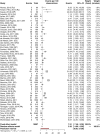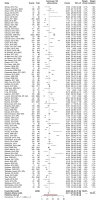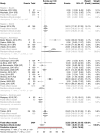Prevalence of human papillomavirus (HPV) in Brazil: A systematic review and meta-analysis
- PMID: 32084177
- PMCID: PMC7034815
- DOI: 10.1371/journal.pone.0229154
Prevalence of human papillomavirus (HPV) in Brazil: A systematic review and meta-analysis
Abstract
Objectives: This study aimed to estimate the prevalence of genital, anal and oral HPV infection in Brazil through systematic review and meta-analysis.
Methods: We searched EMBASE, LILACS, MEDLINE, Web of Science and SciELO from inception to December 2018. Original research articles that assessed the prevalence of genital (i.e., cervical, penile), anal and oral HPV infection in Brazil were selected in pairs by independent authors. No sex, age, HPV vaccination, language or date restrictions were applied. HPV prevalence was estimated and stratified according to risk factors population and by geographic area throughout the country. The study prevalence was pooled using a random effects model. Analysis was performed using R (version 3.5.2), packages meta version 4.9-4 and metaphor 2.0-0. This review is registered on PROSPERO under protocol number CRD42016032751.
Results: We identified 3,351 references. After the screening process, 139 of them were eligible for this systematic review (57,513 total participants). Prevalence of cervical HPV was 25.41% (95% CI 22.71-28.32). Additionally, prevalence was 36.21% (95% CI 23.40, 51.33) in the penile region, 25.68% (95%CI 14.64, 41.04) in the anal region, and 11.89% (95%CI 6.26, 21.43) in the oral region. Subgroup analysis showed prevalence in each anatomic site was higher in high-risk populations.
Conclusion: The prevalence of HPV is high in the Brazilian population and varies by population risk and anatomic body site, with lower rates in the oral cavity compared to that in the cervical, penile and anal region. Studies on HPV have primarily been developed to evaluate infection and cancer in the cervical region. There is a profound lack of HPV data in many geographic regions of Brazil and for different anatomic sites.
Conflict of interest statement
The authors have declared that no competing interests exist.
Figures

























References
-
- Ferlay J, Ervik M, Lam F, Colombet M, Mery L, Piñeros M, et al. Global Cancer Observatory: Cancer Today. Lyon, France: International Agency for Research on Cancer; 2018. https://gco.iarc.fr/today
-
- Giuliano AR, Nyitray AG, Kreimer AR, Pierce Campbell CM, Goodman MT, Sudenga SL, et al. EUROGIN 2014 roadmap: differences in human papillomavirus infection natural history, transmission and human papillomavirus-related cancer incidence by gender and anatomic site of infection. Int J Cancer. 2015;136: 2752–2760. 10.1002/ijc.29082 - DOI - PMC - PubMed
-
- Ayres ARG, Silva GA. Cervical HPV infection in Brazil: systematic review. Rev Saúde Pública. 2010;44: 963–974. - PubMed
Publication types
MeSH terms
LinkOut - more resources
Full Text Sources
Medical

